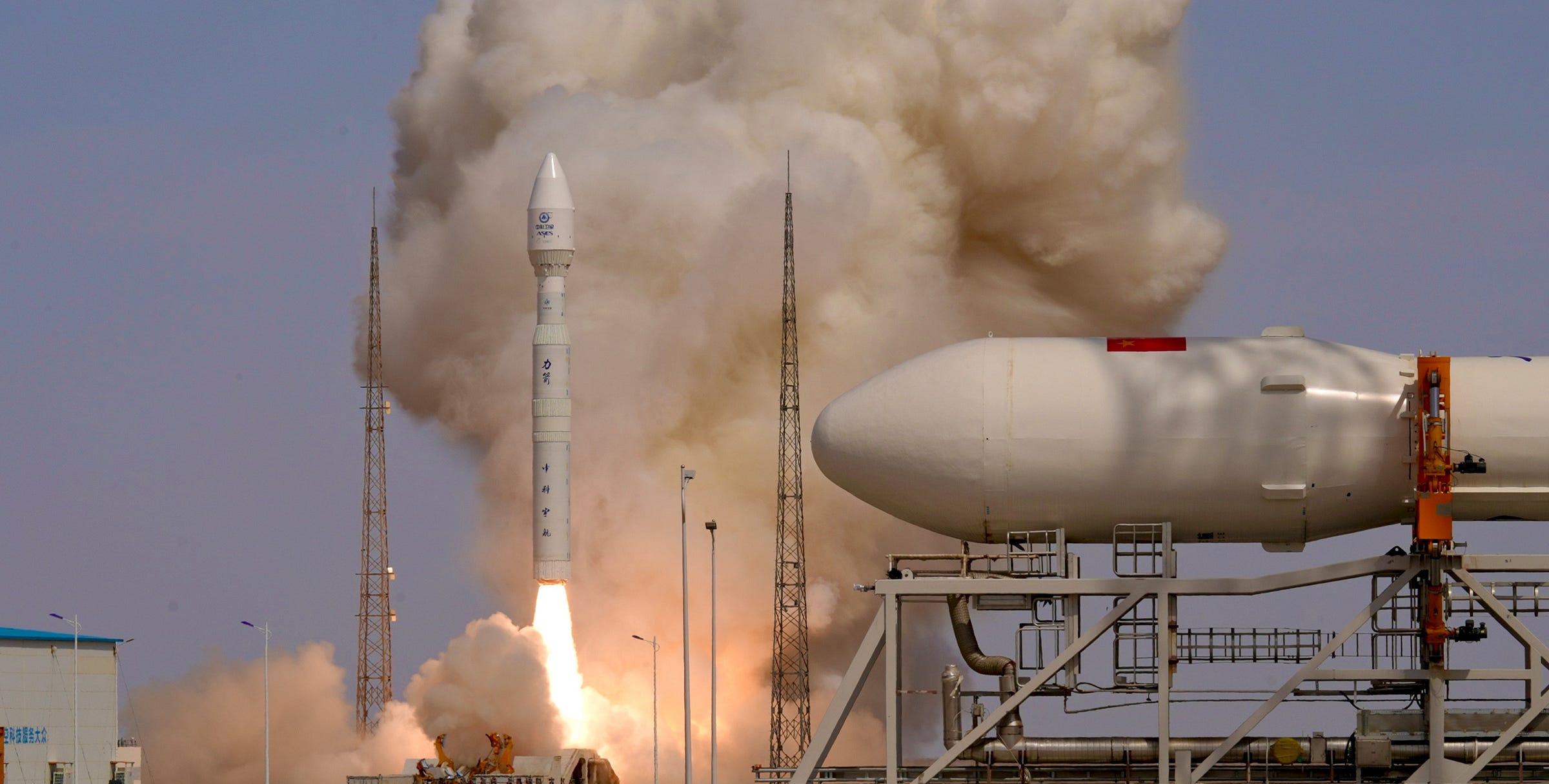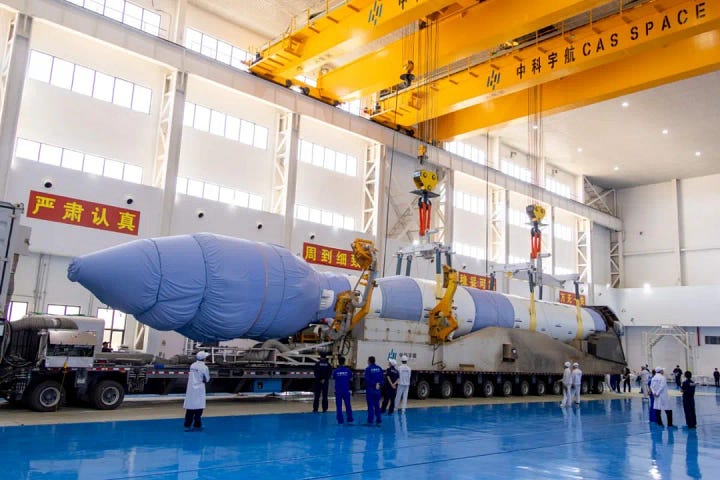International Business for CAS Space [Kinetica-1 Y10]
Seven satellites were launched from Jiuquan, with two from abroad.

Out of Launch Area 130 at the Jiuquan Satellite Launch Center at 15:33 China Standard Time (07:33 am Universal Coordinated Time) on August 19th, CAS Space’s Kinetica-1 flew into sun-synchronous orbit carrying multiple satellites.
A total of seven spacecraft were atop Kinetica-1: ThumbSat-1, ThumbSat-2, Zhongke-05 (中科卫星05), Duogongneng Shiyan-2-01 (多功能试验二号01), Duogongneng Shiyan-2-02 (多功能试验二号02), Duogongneng Shiyan-2-03 (多功能试验二号03), and Tianyan-26 (天雁26).
Two of the satellites heading into orbit today were from Mexico, for CAS Space’s second international customer. The Mexican spacecraft being launched were ThumbSat’s ThumbSat-1 and ThumbSat-2, small in size and approximately 100 grams in weight, both femtosatellites. Both spacecraft are part of space education outreach programs set to provide opportunities to students worldwide. Alongside that mission, ThumbSat-1 is hosting an imaging payload to capture a photo of itself in orbit, while ThumbSat-2 is carrying an artistic payload onboard.
For China Science and Technology Satellite (中科卫星科技集团有限公司), the Zhongke-05, known as AIRSAT-05 in English and also called as Haishao-2 (海哨二号), a remote sensing satellite was onboard. The spacecraft utilizes an X-band synthetic aperture radar to capture images of the Earth below, which are planned to support natural resource and agricultural monitoring, natural disaster response planning, and urban planning alongside a spacecraft launched in December 2024.
Tianyan-26 is another remote sensing satellite, utilizing visible and infrared light imaging onboard the lightweight and miniaturized spacecraft. The satellite was jointly developed by Shanghai ASES Aerospace Technology Co Ltd (上海埃依斯航天科技有限公司) and Henan Polytechnic University (河南理工大学) with miniaturization and infrared technologies from Shaanxi Nuowei Beidou Information Technology Co Ltd (陕西诺维北斗信息科技股份有限公司).
Details on the three Duogongneng Shiyan-2 satellites, translated as Multifunctional Test 2, have not been shared and may not be, depending on their owner and operator.
According to CAS Space in their post-launch blog post, today’s Kinetica-1 flight used the company’s new launch vehicle assembly facility at the Jiuquan Satellite Launch Center for the first time. Use of the facility is said to have substantially shortened launch preparation processes.
This launch held significance beyond its commercial success, as the rocket was decorated with calligraphy for the magazine China Women (中国妇女), written by Chairman Mao Zedong (毛泽东), on the fairing and the ‘Four Selfs ‘ spirit, self-respect, self-confidence, self-reliance, self-improvement (自尊自信自立自强), on the first-stage. CAS Space added this design onto the rocket in collaboration with the All-China Women’s Federation (中华全国妇女联合会) to commemorate progress towards equality and the contributions of China's 689 million women.
In the near future, the company says they are exploring launching fifty satellites in one mission to expand its market offerings. Alongside that, a higher flight cadence and lower costs are being sought with Kinetica-1.
Today’s launch was the 8th launch for Kinetica-1 and for CAS Space. This was also the 49th launch from China in 2025.
Liftoff video via 大漠问天 on WeChat. Recap video via CAS Space on Weibo.
Check out the previous launch from CAS Space
CAS Space is Back in Action! [Kinetica-1 Y7]
CAS Space’s Kinetica-1 launch vehicle performed its return-to-flight mission earlier today from the Jiuquan Satellite Launch Center, at 12:05 China Standard Time (04:05 Universal Coordinated Time) on May 21st. For the mission, six customer…
What is Kinetica-1?
This section is for those less familiar with China's various commercial launch vehicles.
Kinetica-1 is CAS Space's first launch vehicle and consists of four stages, all burning solid fuel. CAS Space offers the ability to launch a single satellite to utilize all of the rocket's payload capacity, however more 'rideshare' missions occur for multiple satellites to be delivered in one launch.
The payload capacity of the launch vehicle is currently as follows:
2,000 kilograms to low Earth orbit
1,500 kilograms to a 500-kilometer sun-synchronous orbit
The first-stage is powered by a solid rocket booster that burns an unspecified solid fuel, generating 200 tons of thrust. The second-stage is also powered by a solid rocket booster, producing 110 tons of thrust with the same unidentified propellant. The-third stage, also using the undisclosed propellant, generates 45 tons of thrust. Finally, the fourth-stage is powered by another solid rocket booster, providing 8 tons of thrust with the same solid propellant.
On its launch pad, Kinetica-1 stands at 30 meters tall. The first two stages have a diameter of 2.65 meters, the fairing has a diameter of either 2.65 or 3.35 meters. When prepared for launch Kinetica-1 weighs a believed 135,000 kilograms.
So far, Kinetica-1 has flown all of its missions from CAS Space’s launch facility at the Jiuquan Satellite Launch Center.







![CAS Space is Back in Action! [Kinetica-1 Y7]](https://substackcdn.com/image/fetch/$s_!8C5o!,w_1300,h_650,c_fill,f_auto,q_auto:good,fl_progressive:steep,g_auto/https%3A%2F%2Fsubstack-post-media.s3.amazonaws.com%2Fpublic%2Fimages%2Ffeb71669-9d87-4d23-9abd-945e3aa8e3a6_3798x2210.jpeg)
